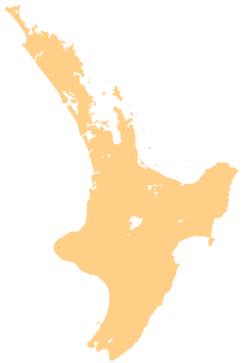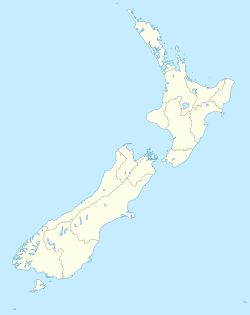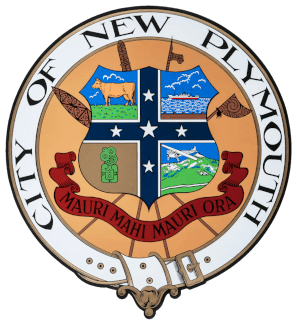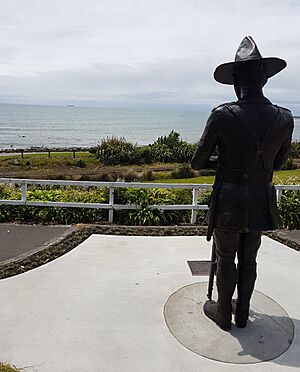New Plymouth facts for kids
Quick facts for kids
New Plymouth
Ngāmotu (Māori)
|
|
|---|---|

New Plymouth city skyline looking south from the foreshore with Mount Taranaki on the horizon.
|
|
| Country | New Zealand |
| Region | Taranaki |
| Territorial authority | New Plymouth District |
| Settled | 31 March 1841 |
| NZ Parliament | New Plymouth Te Tai Hauāuru (Māori) |
| Area | |
| • Territorial | 2,205.6 km2 (851.6 sq mi) |
| • Urban | 74.79 km2 (28.88 sq mi) |
| Population | |
| • Territorial | 88,900 |
| • Density | 40.306/km2 (104.39/sq mi) |
| • Urban | 59,600 |
| Time zone | UTC+12 (NZST) |
| • Summer (DST) | UTC+13 (NZDT) |
| Postcode(s) |
4310, 4312
|
| Area code(s) | 06 |
New Plymouth (called Ngāmotu in Māori) is a major city in the Taranaki region. It sits on the west coast of the North Island of New Zealand. The city gets its name from Plymouth, England, where its first European settlers came from.
The New Plymouth District includes New Plymouth City and several smaller towns. It's the 10th largest district in New Zealand. About two-thirds of the Taranaki Region's population lives here. New Plymouth is a key service hub for the region. Its main industries include dairy farming, oil, natural gas, and petrochemical production. It's also the financial heart of the region.
New Plymouth is famous for its beautiful botanic gardens, like Pukekura Park. Other cool spots include the Len Lye Centre and Art Gallery. You can also enjoy the 13 km (8.1 mi) New Plymouth Coastal Walkway along the Tasman Sea. Don't miss the Wind Wand, a 45-metre-tall (148 ft) artwork by Len Lye. You'll also see Paritutu Rock and amazing views of Mount Taranaki.
In 2021, New Plymouth was named the most liveable city for its size by the International Awards for Liveable Communities. In 2023, Keep New Zealand Beautiful called it New Zealand's most beautiful small city. The city also won many awards in 2008. In 2010, it became one of two "Model Communities" for walking and cycling. This meant it received $3.71 million to improve paths and programs for walkers and cyclists.
Contents
- History of New Plymouth
- Exploring New Plymouth's Geography
- How New Plymouth is Governed
- New Plymouth's Population
- Industry and Utilities in New Plymouth
- Fun Things to Do in New Plymouth
- Awards New Plymouth Has Won
- Getting Around New Plymouth
- Emergency Services in New Plymouth
- Education in New Plymouth
- Media in New Plymouth
- Famous People from New Plymouth
- Sister Cities
- See also
History of New Plymouth
For hundreds of years, the area where New Plymouth now stands was home to several Māori iwi (tribes). Around 1823, Māori people started meeting European whalers and traders. These traders arrived by schooner to buy flax.
In 1828, Richard "Dicky" Barrett set up a trading post at Ngāmotu. He traded with local Māori. Barrett also helped the New Zealand Company buy land from them. The Plymouth Company then took over this land. They aimed to bring settlers from the West Country of England. Surveyor Frederic Carrington designed the city's street layout.
The first settlers arrived on the ship William Bryan on March 31, 1841. Soon after, disagreements over land ownership began between Māori and settlers. By 1860–1861, New Plymouth became a fortified town. More than 3,500 Imperial soldiers, along with local volunteers, fought Māori in the First Taranaki War.
Exploring New Plymouth's Geography
City Suburbs: West to East
New Plymouth has many suburbs. Here are some of them, listed from west to east:
- Spotswood
- Whalers Gate
- Moturoa
- Marfell
- Blagdon
- Hurdon
- Lynmouth
- Westown
- Ferndale
- Frankleigh Park
- Vogeltown
- Brooklands
- Welbourn
- Strandon
- Highlands Park
- Merrilands
- Mangorei
- Fitzroy
- Waiwhakaiho
- Glen Avon
Nearby Towns and Settlements
Several smaller towns are located close to New Plymouth:
New Plymouth's Climate
New Plymouth has a mild, wet climate. In summer, the average afternoon temperature is 21–22 °C (70–72 °F). Summer nights are around 12–13 °C (54–55 °F). Winters are mild, with afternoons at 13–14 °C (55–57 °F) and nights at 5–6 °C (41–43 °F). The city gets about 1,432 mm (56.4 in) of rain each year. Snow is very rare, but it did snow on August 15, 2011. In 2021, a New Plymouth spot was named the sunniest in New Zealand.
| Climate data for New Plymouth (1991–2020) | |||||||||||||
|---|---|---|---|---|---|---|---|---|---|---|---|---|---|
| Month | Jan | Feb | Mar | Apr | May | Jun | Jul | Aug | Sep | Oct | Nov | Dec | Year |
| Record high °C (°F) | 30.6 (87.1) |
29.5 (85.1) |
29.0 (84.2) |
24.9 (76.8) |
21.7 (71.1) |
19.8 (67.6) |
18.0 (64.4) |
19.9 (67.8) |
21.6 (70.9) |
22.3 (72.1) |
26.4 (79.5) |
29.9 (85.8) |
30.6 (87.1) |
| Mean daily maximum °C (°F) | 21.8 (71.2) |
22.5 (72.5) |
21.3 (70.3) |
19.0 (66.2) |
16.5 (61.7) |
14.3 (57.7) |
13.5 (56.3) |
14.0 (57.2) |
15.2 (59.4) |
16.3 (61.3) |
17.8 (64.0) |
20.2 (68.4) |
17.7 (63.9) |
| Daily mean °C (°F) | 17.6 (63.7) |
18.2 (64.8) |
16.8 (62.2) |
14.8 (58.6) |
12.7 (54.9) |
10.7 (51.3) |
9.7 (49.5) |
10.3 (50.5) |
11.6 (52.9) |
12.8 (55.0) |
14.0 (57.2) |
16.3 (61.3) |
13.8 (56.8) |
| Mean daily minimum °C (°F) | 13.4 (56.1) |
13.8 (56.8) |
12.3 (54.1) |
10.6 (51.1) |
8.9 (48.0) |
7.1 (44.8) |
5.9 (42.6) |
6.5 (43.7) |
8.0 (46.4) |
9.2 (48.6) |
10.1 (50.2) |
12.5 (54.5) |
9.9 (49.8) |
| Record low °C (°F) | 4.2 (39.6) |
2.8 (37.0) |
2.6 (36.7) |
0.0 (32.0) |
−0.8 (30.6) |
−2.4 (27.7) |
−2.6 (27.3) |
−2.3 (27.9) |
−2.2 (28.0) |
−0.1 (31.8) |
1.2 (34.2) |
2.1 (35.8) |
−2.6 (27.3) |
| Average rainfall mm (inches) | 76.3 (3.00) |
89.8 (3.54) |
91.1 (3.59) |
117.1 (4.61) |
149.4 (5.88) |
143.6 (5.65) |
141.3 (5.56) |
128.8 (5.07) |
122.9 (4.84) |
127.0 (5.00) |
103.7 (4.08) |
119.3 (4.70) |
1,410.3 (55.52) |
| Average rainy days (≥ 1.0 mm) | 8.1 | 7.8 | 8.6 | 10.3 | 13.6 | 14.6 | 14.5 | 14.8 | 14.2 | 12.9 | 10.9 | 11.5 | 141.8 |
| Average relative humidity (%) | 81.2 | 82.5 | 83.2 | 82.7 | 85.7 | 85.9 | 86.0 | 84.8 | 82.9 | 83.6 | 80.0 | 80.9 | 83.3 |
| Mean monthly sunshine hours | 260.1 | 235.1 | 227.0 | 180.8 | 149.9 | 125.5 | 142.5 | 170.2 | 171.0 | 200.9 | 225.4 | 229.7 | 2,318.1 |
| Mean daily daylight hours | 14.6 | 13.6 | 12.3 | 11.0 | 10.0 | 9.5 | 9.7 | 10.6 | 11.8 | 13.1 | 14.3 | 14.9 | 12.1 |
| Percent possible sunshine | 57 | 61 | 60 | 55 | 48 | 44 | 47 | 52 | 48 | 49 | 53 | 50 | 52 |
| Source 1: NIWA Climate Data | |||||||||||||
| Source 2: Météo Climat Weather Spark | |||||||||||||
How New Plymouth is Governed
From Province to City
The New Zealand Constitution Act 1852 created the New Plymouth Province. This province covered a large area of 400,000 hectares. Five years later, its name changed to Taranaki Province. This provincial system ended in 1876.
New Plymouth formed a Town Board in 1863. In August 1876, it officially became a borough. Even then, some people from other big cities called it a "dullest hole." But many, like author E. W. Payton, found it a "quiet, unassuming place."
Over the years, New Plymouth grew by adding nearby areas. Fitzroy Town District joined in 1911. Vogeltown, Frankleigh Park, and Westown were added a year later. By 1913, the town had 7,538 people. More land was added in the 1930s, 40s, and 50s. New Plymouth was officially declared a city in 1949.
New Plymouth District Council Today
In 1989, local governments across New Zealand were reorganized. The New Plymouth City Council merged with other councils to form the New Plymouth District Council. This new council covers a much larger area.
Every three years, voters in the New Plymouth District elect a mayor and 14 councillors. They also elect 16 community board members. These elected officials make decisions for the district. The current mayor of New Plymouth is Neil Holdom.
The council manages many services for the district. This includes maintaining over 280 parks, managing waste water, and issuing permits. They also provide libraries and other fun services.
New Plymouth's Population
| Historical population | ||
|---|---|---|
| Year | Pop. | ±% p.a. |
| 2006 | 49,395 | — |
| 2013 | 52,872 | +0.98% |
| 2018 | 57,219 | +1.59% |
In 2018, New Plymouth's City Ward had a population of 57,219 people. This was an increase of 8.2% since 2013. There were 22,269 households in the city. The population included 27,870 males and 29,346 females. The average age was 40.8 years.
Most people in New Plymouth are of European/Pākehā background (84.9%). About 15.9% identify as Māori. Other groups include Pacific peoples (2.4%) and Asian (6.6%). About 18.1% of the people were born overseas.
When asked about religion, 50.7% said they had no religion. About 37.3% were Christian. Other religions like Hindu, Muslim, and Buddhist were also present.
For those aged 15 and older, 19.3% had a university degree or higher. The average income was $30,500. About 46.7% of people aged 15 and over worked full-time.
Industry and Utilities in New Plymouth
New Plymouth first got electric power in January 1906. It came from the Mangorei power station. The New Plymouth Power Station started in 1974. It was designed to run on natural gas or fuel oil.
People began looking for oil on the New Plymouth coast in 1865. Small amounts of oil were found on the shore. The first oil for sale was found in January 1866. A refinery opened in 1913, but oil production stopped around 1972.
In 1970, New Plymouth was one of the first New Zealand towns to get natural gas. This came from the Kapuni gas field. Later, the offshore Maui A well started producing natural gas in the late 1970s. This led to a growing energy and petrochemical industry.
Powerco manages the local electricity and natural gas networks in the city. Electricity comes from Transpower's national grid. Natural gas comes from First Gas's system.
Ivon Watkins-Dow was a major industrial company in the city. They made agricultural chemicals. In 2005, a study found that people living near their factory between 1962 and 1987 had higher levels of certain chemicals. In 2007, the Ministry of Health offered a health support program for those affected. This included free annual medical check-ups for people who lived, worked, or studied near the factory.
Fun Things to Do in New Plymouth
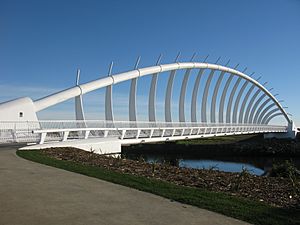
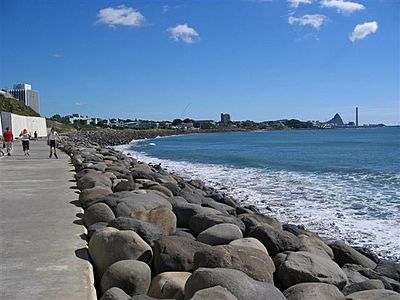
New Plymouth is known for its exciting events. These include the annual TSB Bank Festival of Lights and the Taranaki Powerco Garden Spectacular. The city also hosts WOMAD and the Taranaki Arts Festival. You can also watch international sports like rugby, surfing, cricket, and tennis. Big music stars like Sir Elton John and Fleetwood Mac have performed here.
The city is famous for its gardens because of its rich volcanic soil. Pukekura Park is a 52-hectare park in the city center. It's considered a Garden of National Significance. Pukeiti is another important garden, known for its rhododendrons.
Pukekura Park hosts the TSB Bank Festival of Lights. This free event runs from mid-December to early February. The park becomes a magical place with lights every evening.
Near the central city foreshore is Puke Ariki. This unique building combines a museum, library, and information center. Close by is the Govett-Brewster Art Gallery, a modern art museum. It includes the Len Lye Centre, dedicated to filmmaker and artist Len Lye.
The New Plymouth Coastal Walkway is a 13 km path along the sea. It stretches almost the entire length of the city. This path is great for walking, running, cycling, or skating. It includes the famous Te Rewa Rewa Bridge. The walkway has won many awards, including the best New Zealand cycle facility in 2008.
Centre City Shopping Centre is the main mall in New Plymouth. It has over 65 shops and services.
Awards New Plymouth Has Won
New Plymouth has received several awards for being a great place to live:
- In 2021, it won "Most Liveable City" (for cities with 75,000–150,000 people) at the International Awards for Liveable Communities.
- In 2008, North and South Magazine named it "Top Town." They called it "the best place in New Zealand to live, love, work and raise a family."
- Also in 2008, New Plymouth won three awards at the 11th International Awards for Liveable Communities in China:
- Whole City Gold award (for its population size)
- Award for Community Sustainability
- Gold award for a community project – the Coastal Walkway.
Getting Around New Plymouth
A railway line between New Plymouth and Waitara was finished in 1875. Another line south to Stratford opened in 1879. This line reached Hāwera in 1881. By 1885, the line to Wellington was complete. Passenger trains like the New Plymouth Express started running in 1886. A direct railway route to Auckland opened in 1932. However, all regular passenger train services to New Plymouth stopped by 1983. Now, only special excursion trains visit.
The breakwater at Ngamotu was finished in 1883. This made the port safer for ships. Port Taranaki is now the only deep-water port on New Zealand's west coast. It's very important for the region's transport.
New Plymouth had an electric tramway system starting in 1916. Petrol-powered buses began in 1920. The tramway closed in 1954 and was replaced by trolley buses, which ran until 1967.
The first aircraft landed at the racecourse in 1920. Commercial flights started from Bell Block airport in 1937. This airport became RNZAF Bell Block during World War II. The current airport opened in 1966, about 3 km (1.9 mi) northeast of the old site.
Emergency Services in New Plymouth
New Plymouth has two fire stations. The main station is near the city center. It has four fire trucks and three special vehicles. Eight firefighters staff this station 24/7. They respond to calls in the city and nearby areas. The New Plymouth West Volunteer Fire Brigade is in Spotswood. It has one fire truck and helps protect Port Taranaki and gas tanks.
Police stations are located throughout the city. The main police station is on Powderham Street. Other stations are in Fitzroy, Westown, and Bell Block.
St John Ambulance provides all ambulance services for Taranaki. Their main station is at Taranaki Base Hospital. The Taranaki Rescue Helicopter Trust also helps with search, rescue, and patient transfers. Their helicopter is based at Taranaki Base Hospital.
Port Taranaki is the home port for HMNZS Endeavour. However, this ship is usually based at the Devonport Naval Base in Auckland.
Education in New Plymouth
New Plymouth has many schools in its suburbs. These include schools in Fitzroy, Frankleigh Park, Hurdon, Lynmouth, Mangorei, Marfell, Merrilands, Moturoa, Spotswood, Strandon, Vogeltown, Welbourn, Westown and Brooklands. The Western Institute of Technology at Taranaki has its main campus in Welbourn.
For high school, there are single-sex schools:
- New Plymouth Boys' High School (for boys, years 9–13)
- New Plymouth Girls' High School (for girls, years 9–13)
The Boys' High School started in 1882, and the Girls' High School became separate in 1914.
There are also state-integrated Catholic schools:
- Francis Douglas Memorial College (for boys, years 7–13)
- Sacred Heart Girls' College (for girls, years 7–13)
Spotswood College is the only co-educational high school in the city.
Media in New Plymouth
Local Print Media
- Taranaki Daily News – started in 1857
- Taranaki Midweek
- South Taranaki Star
- Stratford Press
Local Radio Stations
- More FM 93.2FM – has local morning shows
- The Hits 90FM – has local daytime shows
- Access Radio Taranaki 104.4FM – features local community programs
- The Most FM 100.4FM – offers local programming
- Cruize FM – available only online
- Hokonui Gold – has local morning shows
- Newstalk ZB – has a local Saturday morning sports show
Other radio stations are broadcast in Taranaki but come from Auckland or Wellington.
Local Television
- 7 Taranaki – this station closed down in 2007.
The main TV and FM radio transmitter for New Plymouth is on Mount Taranaki. It's about 25 km (16 mi) south of the city. Digital TV (Freeview) is available in New Plymouth from this transmitter.
Famous People from New Plymouth
Many notable people have connections to New Plymouth.
Arts and Entertainment
- Melanie Lynskey (born 1977), actress
- Anthony McCarten (born 1961), author and screenwriter
- Stan Walker (born 1990), Australian Idol winner and singer
- Michael Smither (born 1939), famous painter and composer
- Francis Upritchard (born 1976), contemporary artist
- Keith Waite (1927–2014), well-known cartoonist
Sports Stars
- Will Young (born 1992), Black Caps batsman (cricket)
- Beauden Barrett (born 1991), rugby union player
- Jordie Barrett (born 1997), rugby union player
- Scott Barrett (born 1993), rugby union player
- Michaela Blyde (born 1995), rugby sevens player
- Kendra Cocksedge (born 1988), rugby union player and cricketer
- Conrad Smith (born 1981), rugby union coach and former player
- Paige Hareb (born 1990), professional surfer
Other Notable People
- Sir Frederic Truby King (1858–1938), founder of the Plunket Society (a child health organization)
- Beatrice Tinsley (1941–1981), astronomer and cosmologist
- Jim Hickey (born 1949), weather presenter
- Toni Street (born 1983), television presenter and sports commentator
Sister Cities
New Plymouth has two sister cities, which means they have friendly relationships and cultural exchanges:
- Kunming, Yunnan, China
- Mishima, Shizuoka, Japan
See also
 In Spanish: Nueva Plymouth para niños
In Spanish: Nueva Plymouth para niños



